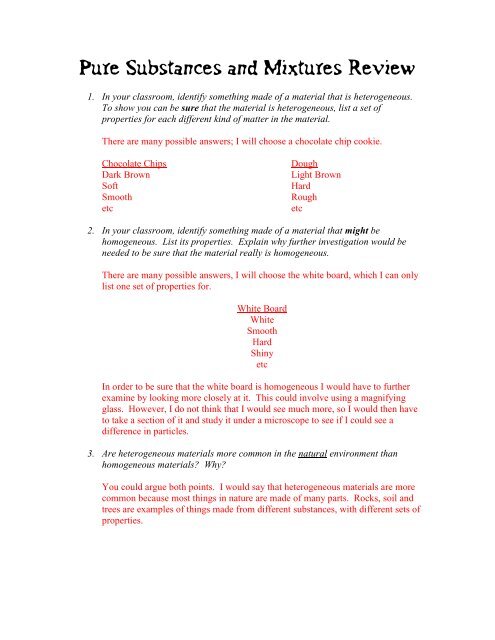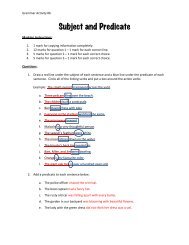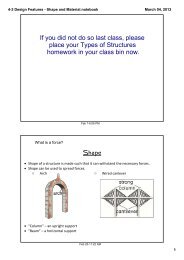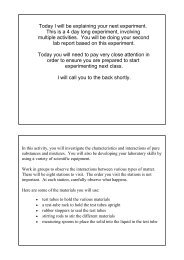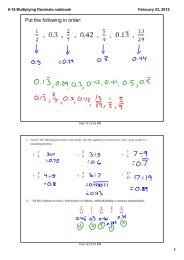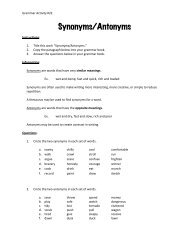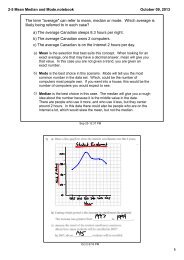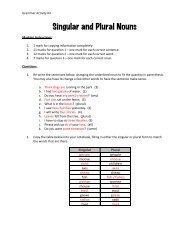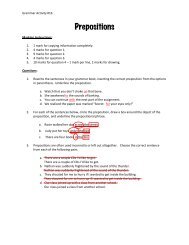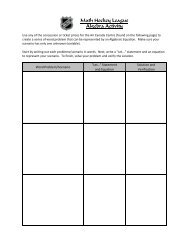Pure Substances and Mixtures Review
Pure Substances and Mixtures Review
Pure Substances and Mixtures Review
You also want an ePaper? Increase the reach of your titles
YUMPU automatically turns print PDFs into web optimized ePapers that Google loves.
<strong>Pure</strong> <strong>Substances</strong> <strong>and</strong> <strong>Mixtures</strong> <strong>Review</strong><br />
1. In your classroom, identify something made of a material that is heterogeneous.<br />
To show you can be sure that the material is heterogeneous, list a set of<br />
properties for each different kind of matter in the material.<br />
There are many possible answers; I will choose a chocolate chip cookie.<br />
Chocolate Chips<br />
Dark Brown<br />
Soft<br />
Smooth<br />
etc<br />
Dough<br />
Light Brown<br />
Hard<br />
Rough<br />
etc<br />
2. In your classroom, identify something made of a material that might be<br />
homogeneous. List its properties. Explain why further investigation would be<br />
needed to be sure that the material really is homogeneous.<br />
There are many possible answers, I will choose the white board, which I can only<br />
list one set of properties for.<br />
White Board<br />
White<br />
Smooth<br />
Hard<br />
Shiny<br />
etc<br />
In order to be sure that the white board is homogeneous I would have to further<br />
examine by looking more closely at it. This could involve using a magnifying<br />
glass. However, I do not think that I would see much more, so I would then have<br />
to take a section of it <strong>and</strong> study it under a microscope to see if I could see a<br />
difference in particles.<br />
3. Are heterogeneous materials more common in the natural environment than<br />
homogeneous materials? Why?<br />
You could argue both points. I would say that heterogeneous materials are more<br />
common because most things in nature are made of many parts. Rocks, soil <strong>and</strong><br />
trees are examples of things made from different substances, with different sets of<br />
properties.
4. Are heterogeneous materials more common in the human-made environment than<br />
homogeneous materials? Why?<br />
You could argue both points. I would say heterogeneous materials are more<br />
common because, even though we filter <strong>and</strong> process materials, the majority of<br />
things are made of multiple substances, each with its own set of properties.<br />
5. Explain how an underst<strong>and</strong>ing of mixtures <strong>and</strong> pure substances can help people<br />
make decisions about what to do when:<br />
h<strong>and</strong>ling materials in the school laboratory<br />
h<strong>and</strong>ling materials, such as paint thinner, at home<br />
hearing about an "air quality advisory" on the news<br />
By underst<strong>and</strong>ing pure substances <strong>and</strong> mixtures, one would know of any safety<br />
precautions that need to be taken. It would be understood that when substances<br />
are mixed the properties could change.<br />
<strong>Substances</strong> can also be harmful because of their particular properties, which may<br />
be found on safety symbols.<br />
An air quality advisory indicates that smog, a mixture of air <strong>and</strong> pollutants, is<br />
present, so you would know to avoid the smog.<br />
6. Use the particle theory to explain why a mixture can be either homogeneous or<br />
heterogeneous.<br />
A mixture can be homogeneous or heterogeneous, depending on how the particles<br />
of each substance within the mixture are scattered throughout the mixture. In a<br />
heterogeneous mixture, the particles of each substance can be seen <strong>and</strong> the<br />
mixture has more than one set of properties. In a homogeneous mixture, the<br />
particles are evenly scattered <strong>and</strong> the properties of each substance are blended.<br />
7. Are the particles in each of the following identical or not identical? Give reasons<br />
for your answers.<br />
the bubbles of soda water<br />
the blobs of milk<br />
the pulp bits of orange juice<br />
The bubbles of soda water are not identical, since they are different shapes <strong>and</strong><br />
sizes; however each bubble contains the same gas, carbon dioxide, therefore it can<br />
be assumed that the particles would be identical.<br />
The fat blobs in milk appear to be identical, all relatively the same size. Each is<br />
also the same colour, which would lead to the assumption that the millions of<br />
microscopic blobs in each drop of milk are composed of the same particles.<br />
The bits of pulp in orange juice are not identical, since they are different shapes<br />
<strong>and</strong> sizes. Also, when looking at the bits of pulp, they appear to have different<br />
textures <strong>and</strong> colour variation. This would mean that the particles are not identical<br />
throughout the pulp.


